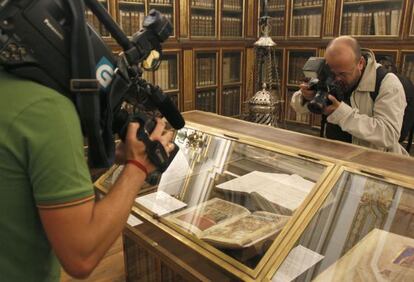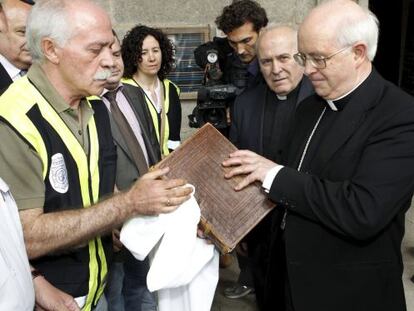Should the cathedral keep its codex?
With only one security guard manning the temple, Santiago seems ill-equipped Debate opens on whether recovered tome should be kept on display or hidden away

"Do not offend God!" exclaims the dean of the Cathedral of Santiago de Compostela, José María Díaz, when an EL PAÍS reporter enquires whether the Codex Calixtinus, a priceless illuminated manuscript from the 12th century, might not be safer someplace else. Ever since the book was recovered this week, almost exactly a year after its theft from the cathedral, many experts have called for better security measures than the Roman Catholic Church can offer for what amounts to the original traveler's guidebook for pilgrims on the Camino de Santiago, or Way of Saint James.
The harshest criticism is pouring from the Royal Galician Academy, whose secretary Xosé Luis Axeitos said: "It is unfeasible to keep the codex inside the cathedral with minimal security measures. It should be protected outside of it. To reject this in order to avoid offending God is absurd, and only proves the lack of professionalism of the speaker."
The Codex Calixtinus, originally attributed to Pope Calixtus II but now believed to have been created by a pilgrim and scholar named Aymeric Picaud, was found inside a garage, wrapped in a garbage bag and surrounded by junk. Manuel Fernández Castiñeiras, a former electrician at the cathedral, admitted to stealing the valuable volume.
Cash-stuffed suitcases and a priceless artifact
Investigators searching the home of the electrician who confessed to stealing the Codex Calixtinus keep making new finds. Police sources said a suitcase containing around 600,000 euros in cash was found in the courtyard of Manuel Fernández Castiñeiras' home in Milladoiro, A Coruña province, in a spot that all residents of the building had access to. Neighbors had alerted authorities to the presence of a suspicious-looking bundle in the courtyard.
The money comes on top of a further 1.2 million euros in cash found inside the electrician's garage, as well as 300,000 US dollars. Yet more money may well turn up, investigators believe. Fernández Castiñeiras, who worked at the cathedral for 25 years, is believed to have slowly stolen the cash from the temple over several years as revenge for being passed over for a professional electricity company when church officials decided to make extensive reforms. The government delegate in Galicia, Samuel Juárez, explained that "it is believed to be money taken from the cathedral area."
Investigators knew there were an additional 600,000 euros lying around somewhere because Fernández Castiñeiras kept written records of everything he took from the cathedral. Three accounting books found inside his house corresponding to the years 2004, 2005 and 2006 showed a red circle around the amount of money taken from the cathedral that year.
The police is not ruling out further searches, however, in case new items turn up. The Codex Calixtinus was found last Wednesday during a search that was in fact aimed at uncovering the suitcase containing 600,000 euros. The 12th-century manuscript was returned to the basilica on Sunday in an event presided by Prime Minister Mariano Rajoy, himself of Galician origin. The judge in charge of the case has released the electrician's son, who was charged with money laundering. Castiñeiras' wife remains on remand but is expected to be released in the coming days as well.
The Attorney's Office and the Galician culture department did not go so far as to demand that the Codex Calixtinus be taken out of the cathedral forever, but they did request that it be made accessible to everyone by exhibiting it in public rather than concealing it in the depths of the cathedral archives. Armored glass, surveillance and proper preservation techniques such as those used to custody other artworks at museums worldwide could be implemented in this case as well, especially now that the theft has made the volume famous.
The regional premier, Alberto Núñez Feijóo, was the first person to say that all the media attention was welcome publicity for the medieval manuscript, hinting at "possibilities of exhibition" as well as the "manifestly improvable" security measures at the cathedral in conversation with the archbishop of Santiago, Julián Barrio.
However, the canon who remains at the helm of the religious chapter despite all that has happened, José María Díaz, has very different plans. What the theft has made apparent, in his opinion, is that the Codex Calixtinus is not hidden well enough. That is why he wants to reduce access to it even further and confine the book to "a secret place" that only two or three people will know about.
Not surprisingly, there are voices of discord within the very body he presides. The director of the cathedral museum, Ramón Yzquierdo, suggested that "if something were to happen to those two or three people," an item that the Church itself considers its second most valuable possession after the relics of Saint James would be lost to the world, even if it was inside the temple.
In any case, the dean insists that a "sizeable investment" in security has already been undertaken. And it is true that the temple has hired the services of an outside firm that is designing a protocol and a surveillance system, as well as training all church personnel (whether choirboys, nuns or tiraboleiros, the men who swing the giant incense burner) to be alert and vigilant at all times.
But Santiago's Romanesque pile is a maze of doors and people, and heads the list of most visited cathedrals in Spain. There is only one security guard working at any one time because church officials say they cannot afford more. The special security team deployed in the holy year of 2010, with people at every door, cost 300,000 euros.
Tu suscripción se está usando en otro dispositivo
¿Quieres añadir otro usuario a tu suscripción?
Si continúas leyendo en este dispositivo, no se podrá leer en el otro.
FlechaTu suscripción se está usando en otro dispositivo y solo puedes acceder a EL PAÍS desde un dispositivo a la vez.
Si quieres compartir tu cuenta, cambia tu suscripción a la modalidad Premium, así podrás añadir otro usuario. Cada uno accederá con su propia cuenta de email, lo que os permitirá personalizar vuestra experiencia en EL PAÍS.
¿Tienes una suscripción de empresa? Accede aquí para contratar más cuentas.
En el caso de no saber quién está usando tu cuenta, te recomendamos cambiar tu contraseña aquí.
Si decides continuar compartiendo tu cuenta, este mensaje se mostrará en tu dispositivo y en el de la otra persona que está usando tu cuenta de forma indefinida, afectando a tu experiencia de lectura. Puedes consultar aquí los términos y condiciones de la suscripción digital.
More information









































